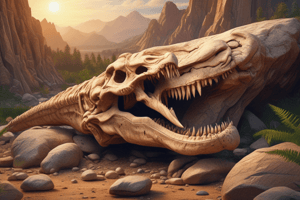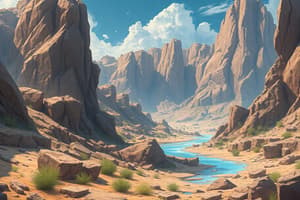Podcast
Questions and Answers
Proterozoic Eon - the first Eukaryotes appeared Eukaryotes - have true ______ on their cells
Proterozoic Eon - the first Eukaryotes appeared Eukaryotes - have true ______ on their cells
nucleus
The first dinosaur was called ______
The first dinosaur was called ______
NYASASAURUS PARRINGTONI
Diapsids (ancestors of dinosaurs) Synapsids (ancestors of ______)
Diapsids (ancestors of dinosaurs) Synapsids (ancestors of ______)
mammals
Mississippian Period - the first winged ______ appeared
Mississippian Period - the first winged ______ appeared
Plateosaurus - flat ______
Plateosaurus - flat ______
Velociraptors - swift ______
Velociraptors - swift ______
William Smith in 1800 - He formulated Fossil Succession. Fossils of one organism succeed one another in a specific and well established order. Geological Time Scale Eon - is the longest subdivision of Geological Time Scale, succeeded by Era, Period, and Epoch. Precambrian Eon - is the super Eon composed of the first three eons. Hadean Eon (4.6 Billion Years Ago) - the solidification of the earth’s continental and oceanic crust. Archean Eon (4 Billion Years Ago) - the evolution of earth’s first life forms. Proterozoic Eon (2.5 Billion Years Ago) - the appearance of multi-celled animals and the gathering of land masses to form continents. Archean Eon - the first life on earth appeared. They are PROKARYOTIC ORGANISMS which means they don’t have a true nucleus. Archaea Bacteria - first life forms Types of Archaea Bacteria includes: 1. Thermophiles - can survive in extremely hot environment. 2. Acidophiles - can survive in an extremely acidic environment. 3. Methanogens - uses Methane to metabolize. 4.
William Smith in 1800 - He formulated Fossil Succession. Fossils of one organism succeed one another in a specific and well established order. Geological Time Scale Eon - is the longest subdivision of Geological Time Scale, succeeded by Era, Period, and Epoch. Precambrian Eon - is the super Eon composed of the first three eons. Hadean Eon (4.6 Billion Years Ago) - the solidification of the earth’s continental and oceanic crust. Archean Eon (4 Billion Years Ago) - the evolution of earth’s first life forms. Proterozoic Eon (2.5 Billion Years Ago) - the appearance of multi-celled animals and the gathering of land masses to form continents. Archean Eon - the first life on earth appeared. They are PROKARYOTIC ORGANISMS which means they don’t have a true nucleus. Archaea Bacteria - first life forms Types of Archaea Bacteria includes: 1. Thermophiles - can survive in extremely hot environment. 2. Acidophiles - can survive in an extremely acidic environment. 3. Methanogens - uses Methane to metabolize. 4.
There are several types of fossils: True form fossils Petrified Molds and casts Carbonized William Smith in 1800 - He formulated Fossil Succession. Fossils of one organism succeed one another in a specific and well established order. Geological Time Scale Eon - is the longest subdivision of Geological Time Scale, succeeded by Era, Period, and Epoch. Precambrian Eon - is the super Eon composed of the first three eons. Hadean Eon (4.6 Billion Years Ago) - the solidification of the earth’s continental and oceanic crust. Archean Eon (4 Billion Years Ago) - the evolution of earth’s first life forms. Proterozoic Eon (2.5 Billion Years Ago) - the appearance of multi-celled animals and the gathering of land masses to form continents. Archean Eon - the first life on earth appeared. They are PROKARYOTIC ORGANISMS which means they don’t have a true nucleus. Archaea Bacteria - first life forms Types of Archaea Bacteria includes: 1. Thermophiles - can survive in extremely hot environment. 2. Acidophiles - can survive in an extremely acidic environment. 3. Methanogens - uses Methane to metabolize. 4.
There are several types of fossils: True form fossils Petrified Molds and casts Carbonized William Smith in 1800 - He formulated Fossil Succession. Fossils of one organism succeed one another in a specific and well established order. Geological Time Scale Eon - is the longest subdivision of Geological Time Scale, succeeded by Era, Period, and Epoch. Precambrian Eon - is the super Eon composed of the first three eons. Hadean Eon (4.6 Billion Years Ago) - the solidification of the earth’s continental and oceanic crust. Archean Eon (4 Billion Years Ago) - the evolution of earth’s first life forms. Proterozoic Eon (2.5 Billion Years Ago) - the appearance of multi-celled animals and the gathering of land masses to form continents. Archean Eon - the first life on earth appeared. They are PROKARYOTIC ORGANISMS which means they don’t have a true nucleus. Archaea Bacteria - first life forms Types of Archaea Bacteria includes: 1. Thermophiles - can survive in extremely hot environment. 2. Acidophiles - can survive in an extremely acidic environment. 3. Methanogens - uses Methane to metabolize. 4.
______ and Fossil Succession ______ - are the remains of plants and animals who lived in the past. They are often preserved in sedimentary rock and other substances. Paleontology - is the study of fossils. Paleontologists - are scientists that study fossils. There are several types of fossils: True form fossils Petrified Molds and casts Carbonized
______ and Fossil Succession ______ - are the remains of plants and animals who lived in the past. They are often preserved in sedimentary rock and other substances. Paleontology - is the study of fossils. Paleontologists - are scientists that study fossils. There are several types of fossils: True form fossils Petrified Molds and casts Carbonized
Geological Time Scale ______ - is the longest subdivision of Geological Time Scale, succeeded by Era, Period, and Epoch. Precambrian ______ - is the super ______ composed of the first three eons. Hadean ______ (4.6 Billion Years Ago) - the solidification of the earth’s continental and oceanic crust. Archean ______ (4 Billion Years Ago) - the evolution of earth’s first life forms. Proterozoic ______ (2.5 Billion Years Ago) - the appearance of multi-celled animals and the gathering of land masses to form continents. Archean ______ - the first life on earth appeared. They are PROKARYOTIC ORGANISMS which means they don’t have a true nucleus. Archaea Bacteria - first life forms Types of Archaea Bacteria includes: 1. Thermophiles - can survive in extremely hot environment. 2. Acidophiles - can survive in an extremely acidic environment. 3. Methanogens - uses Methane to metabolize. 4.
Geological Time Scale ______ - is the longest subdivision of Geological Time Scale, succeeded by Era, Period, and Epoch. Precambrian ______ - is the super ______ composed of the first three eons. Hadean ______ (4.6 Billion Years Ago) - the solidification of the earth’s continental and oceanic crust. Archean ______ (4 Billion Years Ago) - the evolution of earth’s first life forms. Proterozoic ______ (2.5 Billion Years Ago) - the appearance of multi-celled animals and the gathering of land masses to form continents. Archean ______ - the first life on earth appeared. They are PROKARYOTIC ORGANISMS which means they don’t have a true nucleus. Archaea Bacteria - first life forms Types of Archaea Bacteria includes: 1. Thermophiles - can survive in extremely hot environment. 2. Acidophiles - can survive in an extremely acidic environment. 3. Methanogens - uses Methane to metabolize. 4.
Archean Eon (4 Billion Years Ago) - the evolution of earth’s first life forms. Proterozoic Eon (2.5 Billion Years Ago) - the appearance of multi-celled animals and the gathering of land masses to form continents. Archean Eon - the first life on earth appeared. They are PROKARYOTIC ORGANISMS which means they don’t have a true nucleus. Archaea Bacteria - first life forms Types of Archaea Bacteria includes: 1. Thermophiles - can survive in extremely hot environment. 2. Acidophiles - can survive in an extremely acidic environment. 3. Methanogens - uses Methane to metabolize. 4.
Archean Eon (4 Billion Years Ago) - the evolution of earth’s first life forms. Proterozoic Eon (2.5 Billion Years Ago) - the appearance of multi-celled animals and the gathering of land masses to form continents. Archean Eon - the first life on earth appeared. They are PROKARYOTIC ORGANISMS which means they don’t have a true nucleus. Archaea Bacteria - first life forms Types of Archaea Bacteria includes: 1. Thermophiles - can survive in extremely hot environment. 2. Acidophiles - can survive in an extremely acidic environment. 3. Methanogens - uses Methane to metabolize. 4.
Types of ______ includes: 1. Thermophiles - can survive in extremely hot environment. 2. Acidophiles - can survive in an extremely acidic environment. 3. Methanogens - uses Methane to metabolize. 4.
Types of ______ includes: 1. Thermophiles - can survive in extremely hot environment. 2. Acidophiles - can survive in an extremely acidic environment. 3. Methanogens - uses Methane to metabolize. 4.
Plateosaurus - flat ______
Plateosaurus - flat ______
Velociraptors - swift ______
Velociraptors - swift ______
Mississippian Period - the first winged ______ appeared
Mississippian Period - the first winged ______ appeared
The first dinosaur was called ______
The first dinosaur was called ______
Eukaryotes - have true ______ on their cells
Eukaryotes - have true ______ on their cells
Diapsids (ancestors of dinosaurs) Synapsids (ancestors of ______)
Diapsids (ancestors of dinosaurs) Synapsids (ancestors of ______)
Proterozoic Eon - the first Eukaryotes appeared Eukaryotes - have true ______ on their cells
Proterozoic Eon - the first Eukaryotes appeared Eukaryotes - have true ______ on their cells
Mississippian Period - the first winged ______ appeared
Mississippian Period - the first winged ______ appeared
Plateosaurus - flat ______
Plateosaurus - flat ______
Diapsids (ancestors of dinosaurs) Synapsids (ancestors of ______)
Diapsids (ancestors of dinosaurs) Synapsids (ancestors of ______)
Velociraptors - swift ______
Velociraptors - swift ______
Geological Time Scale Eon - is the longest subdivision of Geological Time Scale, succeeded by Era, Period, and Epoch. Precambrian Eon - is the super ______ composed of the first three eons. Hadean Eon (4.6 Billion Years Ago) - the solidification of the earth’s continental and oceanic crust. Archean Eon (4 Billion Years Ago) - the evolution of earth’s first life forms. Proterozoic Eon (2.5 Billion Years Ago) - the appearance of multi-celled animals and the gathering of land masses to form continents. Archean Eon - the first life on earth appeared. They are PROKARYOTIC ORGANISMS which means they don’t have a true ______
Geological Time Scale Eon - is the longest subdivision of Geological Time Scale, succeeded by Era, Period, and Epoch. Precambrian Eon - is the super ______ composed of the first three eons. Hadean Eon (4.6 Billion Years Ago) - the solidification of the earth’s continental and oceanic crust. Archean Eon (4 Billion Years Ago) - the evolution of earth’s first life forms. Proterozoic Eon (2.5 Billion Years Ago) - the appearance of multi-celled animals and the gathering of land masses to form continents. Archean Eon - the first life on earth appeared. They are PROKARYOTIC ORGANISMS which means they don’t have a true ______
Flashcards are hidden until you start studying




